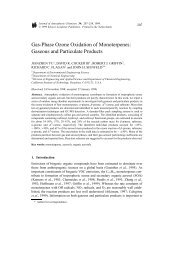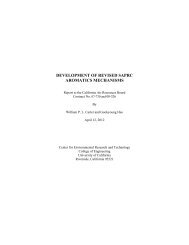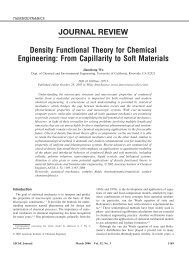Asphaltene precipitation in crude oils: Theory and experiments
Asphaltene precipitation in crude oils: Theory and experiments
Asphaltene precipitation in crude oils: Theory and experiments
You also want an ePaper? Increase the reach of your titles
YUMPU automatically turns print PDFs into web optimized ePapers that Google loves.
Table 9. Model Parameters Fitted Us<strong>in</strong>g Sutherl<strong>and</strong> <strong>and</strong> SW Potential Models for Tank-Oil C1*<br />
s A H A /k (K) H R /k (K) AA RR AA /k (K) AR /k (K)<br />
Sutherl<strong>and</strong> 3 11270.01 1891.03 4.130 4.200 2036.54 2383.34<br />
SW 3 11270.01 1891.03 1.596 1.564 2036.54 2383.34<br />
*k 1.381 10 23 J/K (Boltzman constant). ij ( i i j j )/( i j ).<br />
dures, fixed by model assumptions, or calculated through specific<br />
physical relationships or recent theoretical results (Ortega-<br />
Rodriguez et al., 2004). Only seven parameters (H A , H R , AA ,<br />
RR , AA , AR , <strong>and</strong> s A ) need to be determ<strong>in</strong>ed from experimental<br />
data of the particular oil of <strong>in</strong>terest.<br />
<strong>Asphaltene</strong> Precipitation as a Liquid–Liquid<br />
Separation<br />
The conditions for liquid–liquid isothermal equilibrium are<br />
obta<strong>in</strong>ed by impos<strong>in</strong>g the equality of <strong>in</strong>tensive thermodynamic<br />
functions <strong>in</strong> both phases:<br />
A A (12)<br />
R R (13)<br />
(14)<br />
where superscripts <strong>and</strong> refer to the two equilibrated phases<br />
(the higher-density liquid phase corresponds to the precipitated<br />
phase); is the chemical potential; A <strong>and</strong> R denote asphaltenes<br />
<strong>and</strong> res<strong>in</strong>s, respectively; <strong>and</strong> denotes the osmotic pressure,<br />
recall<strong>in</strong>g that, accord<strong>in</strong>g to the McMillan–Mayer theory, the<br />
pressure to be considered must be the osmotic pressure, where<br />
only the solutes are <strong>in</strong>volved <strong>in</strong> an explicit way <strong>in</strong> the thermodynamic<br />
expressions. As <strong>in</strong> the case of electrolyte solutions,<br />
the chemical potentials of the solutes <strong>and</strong> the osmotic pressure<br />
for each phase <strong>in</strong> the asphaltene–res<strong>in</strong>–oil mixture depend only<br />
on the solutes concentration (asphaltene <strong>and</strong> res<strong>in</strong>) <strong>in</strong> the solvent<br />
(oil). The osmotic pressure is obta<strong>in</strong>ed from the thermodynamic<br />
relationship<br />
V<br />
2<br />
NkT<br />
<br />
i<br />
x i<br />
kT <br />
A<br />
<br />
i1 NkT<br />
(15)<br />
where the chemical potential is calculated from the free energy<br />
A<br />
i A<br />
N i i A, R (16)<br />
T,V,N ji<br />
where V is the total volume of the phase. The thermodynamic<br />
properties are written <strong>in</strong> terms of effective values of composition<br />
<strong>and</strong> density, xˆ i <strong>and</strong> , respectively, which depend only on<br />
the solutes properties,<br />
Nˆ N A N R (17)<br />
xi N i / N i A, R (18)<br />
A R (19)<br />
The total values for the molar fractions <strong>and</strong> densities are given<br />
by<br />
x i <br />
N i<br />
N A N R N m<br />
(20)<br />
i x i /v i A, R (21)<br />
Figure 6. Fitt<strong>in</strong>g of experimental n-heptane titration data us<strong>in</strong>g Sutherl<strong>and</strong> <strong>and</strong> SW potential models.<br />
AIChE Journal October 2004 Vol. 50, No. 10<br />
2561
















